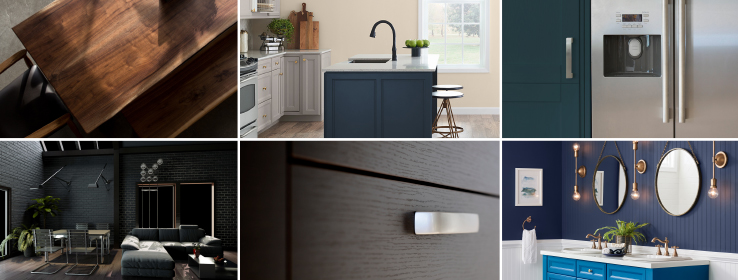How appliances and wood finishes are influencing color trends.
Lauren West and Kiki Redhead are two recent, vital additions to our Sherwin-Williams Color Forecast Team. Their jobs are to track, forecast and manage color trends in furniture, wood products, appliances and other manufactured product finishes.
West has an extensive background in furniture and interior merchandising, and she oversees trend and lifestyle monitoring globally for all wood product market segments. Redhead is the color and trend lead for our Industrial Coatings division and is based in our general industrial headquarters in Minneapolis.
I had the opportunity to connect with these two creative powerhouses to discuss trends in industrial finishes. Their insights on what’s currently popular in the industrial space are important views into what’s coming to interior spaces.
Sue Wadden: Kiki, with your unique visibility into the industrial coatings marketplace, what color trends have you been seeing among appliance manufacturers and others in the interior space?
Redhead: I can tell you that the metals that are trending in automotive and consumer electronics are definitely influencing appliances. Stainless steel is either going to black stainless or it’s going warm, toward bronze. My team also works with furniture and building products, including powder coatings. We are also tracking and forecasting movement toward warmer neutrals: metals like gold, copper, bronze, rose and soft metallic effects.
Blue is very important right now, too. We’re doing extensive exploration incorporating different blues on industrial surfaces, from navy to sky, from high gloss to matte. Matte finishes are softening the heavy appearance of these types of products and toning down metallics from sparkly to shimmery.
Also, customized color is becoming key in appliance and furniture design. Consumers want to be able to swap out the color of their mixer’s bowl, change the handle of their refrigerator or choose the metal finish for their table base. Options are being made readily available, and personal preference can now be achieved.
Wadden: How about you, Lauren? You have such a great perspective on building-product finishes — you’re in the heart of the action down there in Greensboro. How are you seeing color direction change as you work with cabinet manufacturers, furniture, millwork and other building products?
West: Yes, our work at the Sherwin-Williams Global Color and Design Center (GCDC) gives us quite a global outlook. We’re really in the business of creating proprietary color. We’re passionate about design and are on the cusp of what’s next, every day. Our product development research reveals, without a doubt, that bigger color is coming. Neutrals are turning warmer, and saturation is stronger in colors, especially in blue hues. The colors In The Navy SW 9178 (253-C3) and Gale Force SW 7605 (279-C3), as well as custom denim stains, are excellent examples. Also, softer shades of black, such as Urbane Bronze SW 7048 (245-C7), are up-trending.
Wadden: In what ways do each of you think the rules are being rewritten when it comes to interior color palettes?
West: In the wood finishing marketplace, the rules are being rewritten every day because coatings technology continues to bring new opportunities to innovate. Color has the power to bring the raw materials to life. There are a variety of finishes, from opalescents to pops of vibrant color to bleached or “barely there” finishes, that help do this. New browns that are rich with deep espresso are trending upward. And gray is here to stay and will continue to evolve into a staple neutral.
Redhead: I agree with Lauren that there’s a continued desire for something new, color-wise. I also think that consumers’ thought processes are changing. People are thinking of interiors as schemes, or a collective of all the elements in a space. And because of the internet, consumers are savvier about design nomenclature, so now they can better describe the details of their vision to interior designers. Homing in on client expectations will prove more demanding for designers. So I wouldn’t call it a rule so much as I would call it a guideline, but active listening and interpretation through color psychology is quickly becoming a required skill for designers.
Wadden: You each touched on this already, but talk more about how product technology is changing what design professionals are able to do with interior color.
Redhead: The industrial design segments at Sherwin-Williams are maximizing the ability to influence design with new resin technologies, special effect pigments and textures. We’re enhancing the performance and durability of products without compromising the consistency of the color.
When we’re working with manufacturers, we need our technologies to allow our customers to reproduce the same color hundreds of times a day in factories all over the world. They are developing color harmony across substrates, parts and technologies. So the kitchen range knobs, handle, door and side panels all need to match.
The key element in all of this is collaboration with our customers. Being part of the design and product development process from the early stage of trends and concepts sets us up to provide colors, materials and finishes in the newest technologies that interior designers can confidently specify when designing and coloring spaces.
West: At GCDC, we believe in innovation and beauty. We are the team that pushes the limits of creating color for our customers, who create and manufacture the furniture and furnishings that designers use every day. The materials we use are proprietary and allow us to create custom looks for our manufacturer customers. As a result, our exhaustive color and product research and innovation naturally benefit interior designers by giving them more options to thrill their clients.










